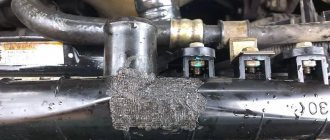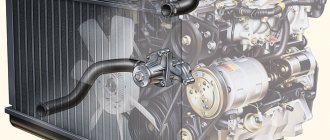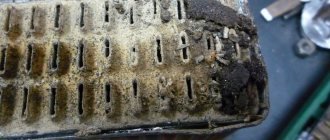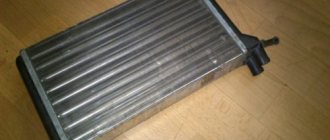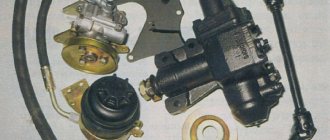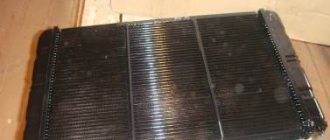A car radiator is the most important part of the cooling system of a modern car. The performance of the engine as a whole depends on how it works. Of course, everyone knows the principle of operation of the internal combustion engine. It is based on a series of small explosions of fuel in the cylinder block. It is not surprising that as a result of this, the components and assemblies of the entire mechanism during operation are heated to very high temperatures and experience enormous loads. If the thermal energy generated during operation is not promptly removed from the engine compartment, then just one trip will be enough for certain components and assemblies of the internal combustion engine to completely fail. To prevent this from happening, the cooling system works.
What is better to fill in in winter: antifreeze or antifreeze?
Experts never tire of saying that almost half of all car engine breakdowns are associated with problems in the cooling system.
Using good technical fluids, timely maintenance and monitoring the tightness and quality of cooling will make engine operation much more convenient. In Russia, drivers have a certain choice among technical fluids: antifreeze or antifreeze. By the way, except for the CIS countries, such a division does not exist anywhere else. However, it is worth determining the difference between these two liquids and understanding what is best to pour into your car in winter to avoid unexpected breakdowns.
Design features
To a person unfamiliar with the design of even the most primitive internal combustion engine, the cooling system may seem like an extremely complex device. However, in reality, everything is not so scary and to understand how it works, it is enough to study only the design features of the device. It consists of the following parts:
It should be added that in any cooling system there is a small and large circle of liquid circulation. Initially, when the engine is just started, circulation occurs in a small circle. This happens until the motor reaches the desired temperature, at which point special bypass valves open and the liquid flows into the large circle. It is on this that the heating of the interior occurs, so the heat in the car always becomes only after the engine has completely warmed up.
And it is also very important for the system to work by choosing the right fluid. Let's talk about how to do this.
The main advantages of antifreeze over antifreeze
In winter, the car's cooling system requires special attention. With the use of good fluid and quality maintenance, you can ensure proper engine operating conditions and get the results you need. Many people believe that there is not much difference in the two types of coolant, but this opinion is wrong.
When choosing antifreeze or antifreeze for winter use, you should pay attention to the following important advantages of antifreeze:
- much more noticeable lubrication effect;
- long-term operation of the liquid itself and the cooling system;
- work at lower temperatures;
- absence of deposits and sediment in the water pump and radiator;
- excellent fluid stability, no changes in condition.
Of course, such properties are demonstrated only by high-quality antifreeze, which is very difficult to find in current car stores. A more affordable and widespread option for coolant is antifreeze, which does not provide such high-quality operation of the cooling system, but also copes well with its tasks.
Why do you need to know this?
Finding out what is filled, Antifreeze or antifreeze, is useful for several reasons:
- The car was recently purchased second hand. It is logical to find out from the previous car owner what is used in the cooling system and when the consumables were last changed. This will allow you to find out when to make a replacement.
- There has been a malfunction in the cooling system. The heating device has become worse and sometimes the power unit overheats. Such problems are often caused by the use of low-quality refrigerant. It is useful to find out what exactly is in the system so that you never use such a product again.
- Even if everything works fine and there is no engine overheating, the car owner still needs to know what is used in the cooling system. At a minimum, so that if there is a shortage of refrigerant volume, you can understand what liquid to buy to add.
Purchasing antifreeze: what to look for?
One of the main problems with coolants is the huge number of fakes. This is the reason why car enthusiasts have serious doubts when choosing. It must be admitted that high-quality antifreeze is also effective in winter and is only inferior to antifreeze in some parameters. But antifreeze is also much cheaper, which gives it a certain advantage.
When choosing antifreeze for the winter, pay special attention to its following properties:
- the viscosity of the liquid should be only slightly greater than that of water;
- an oily structure is a prerequisite for a high-quality liquid;
- It is better to give preference to large cans of antifreeze - it is not recommended to fill different liquids;
- color does not matter - it is achieved by adding certain dyes.
It is very important to maintain normal coolant levels. In winter or summer, the car's expansion tank must always be filled in the required proportions. Keep the coolant level between the minimum and maximum levels.
Step-by-step replacement instructions
Ideally, you need to change the antifreeze to the original one, which was filled in at the factory.
New antifreeze can be added only after the old one has been drained from the cooling system. Adding new coolant itself is even easier than removing old antifreeze, so any car owner can handle this task:
- New antifreeze must be poured into the expansion tank to the maximum mark, then the tank cap must be screwed on.
- Start the car, then turn on the interior heater to maximum.
- Increasing pressure will evenly distribute the liquid in the cooling system. As a result, the level of antifreeze in the expansion tank should drop noticeably.
- Turn off the engine, then after a 20-minute pause, refill the expansion tank with antifreeze to the maximum mark.
- After this, you need to start the engine again and turn on the stove. This procedure must be repeated until the antifreeze level in the tank stops falling after starting the engine.
The last check is carried out a few days after the start of operation of the car with new antifreeze. Topping up is also done if necessary.
As you can see, almost any car owner can cope with replacing antifreeze. It is much more difficult to choose the right coolant
It is best to focus on the car manufacturers’ tolerances, and only then pay attention to the colors and markings. It is not the easiest task to completely drain the coolant, but it is also easy to cope with if you know the various methods for removing used antifreeze from the cooling system
Let's sum it up
If you have the opportunity to purchase really high-quality antifreeze, be sure to do so. You can extend the life of your cooling system, avoid clogging and ineffective operation. But a good antifreeze also copes with the task and cools all engine systems very efficiently.
The driver’s main task is to purchase high-quality technical fluids that are produced at the factory and not counterfeited in a handicraft industry. Only factory options will ensure the safe operation of the power unit. Are there any adherents of using antifreeze among our readers? We will be glad to read reviews about the difference in the use of coolants.
Cleaning the external elements of the radiator
The best option is to flush the radiator with water under pressure. This can be done either in your garage (if you have a suitable compressor) or at the nearest car wash.
The best option for external radiator cleaning is flushing with water under pressure.
This cleaning method perfectly removes even the smallest contaminants, such as poplar fluff that has accumulated between the fins of the radiator. But you need to remember the following:
- the water pressure should not be too strong, since the radiator fins are very thin and easily deformed;
- There should be no aggressive chemical additives in the water. Rubber hoses with clamps and gaskets are attached to the radiator. Aggressive detergents can corrode all this, and the cooling system will lose its seal.
What to put in a car radiator? Antifreeze or antifreeze? We are considering all options
Among novice car enthusiasts, the question arises of what to pour into the car radiator - antifreeze or antifreeze. And you shouldn’t mock the naivety of a newbie. Even among seasoned drivers who have spent many years behind the wheel and put hundreds of thousands of kilometers on their wheels, fierce disputes periodically flare up.
There are fans of antifreeze, and there are supporters of antifreeze. And both sides have a lot of arguments. Moreover, justified and convincing! So you need to sort it out meticulously and decide thoughtfully.
Distilled water
If you want, it is recommended to dilute the antifreeze concentrate ; it can be poured in a 50/50 ratio. YES and in the short term, it is also desirable for filling (I mean getting to the service station).
The thing is that distilled liquid is just H2O without any impurities (salts, etc.) that can settle in the car’s cooling system. Therefore, it is used to dilute antifreeze and antifreeze.
However, again, it’s clean, you can’t fill it, it will cause all the disadvantages that I listed above, unless there is scale! And so it oxidizes the walls, freezes, and boils beautifully. So you can't!
That’s actually the whole answer, if you compare it with old engines, which were flooded and essentially weren’t afraid, so they were repaired every year, or a maximum of two years. Back then the oils were different, there was no antifreeze, and in general the technology was, to put it mildly, far from ideal.
My late grandfather once told me - if back then those engines had oils and fluids like they do now, we would have built more! So, the people were different, they thought about the country, and not about their pockets as they do now.
Source
Did you like the article? Subscribe to the channel to stay up to date with the most interesting materials
Subscribe
A little theory
If anyone has forgotten (or did not know), let us remind you: the engine’s operation is based on a series of explosions of a mixture of air and fuel. It is this that ensures the operation of the pistons and crankshaft. Naturally, the temperature during microexplosions rises to a very convincing figure of 2000°C. No material can survive such heat, so the engine must be continuously cooled.
Additional functions
In addition to reducing the temperature of operating mechanisms, the cooler must meet some other requirements and perform parallel tasks.
- Protect the metal components of the engine from rusting. And this is important, because when metals interact with liquid compounds, corrosion is a very possible thing;
- Lubricate the pump bearing
. Otherwise, due to constant friction, it will gradually wear out and cease to perform its functions;
- Increase the limit after which the liquid boils. It is very important in the summer heat, when engine temperatures are complemented by natural ones.
If you delve into this list, it will become clear why you cannot pour water into the radiator.
Two conditions for normal operation will be violated at once: metal parts will rust, and an unlubricated pump will fail. In a hopeless situation, just to get to the “place”, you can fill the radiator with water for a short time, but using it constantly means ruining the car.
The most popular brands of refrigerants
Today there are several brands that deserve attention from drivers. The following companies produce good auto chemicals for aluminum engines:
- "Tosol-Sintez" A Russian company that produces antifreezes of the popular Felix line. There are four types of compounds that have different properties.
- Liqui Moly. German manufacturer. The compositions from this company are very high quality and today are among the leaders in sales.
- Motul. A French company that pays special attention to the biological safety of materials and the complete safety of users.
- "Obninskorgsintez" A Russian brand engaged in the development and production of Sintec antifreeze.
Various antifreezes are popular in Russia. In addition to these, we can also highlight Long Life and Nord.
Antifreeze or antifreeze?
To be honest, such a division by type exists only in the territory of the former Union. By definition, antifreeze is a compound that lowers the temperature of water. It is made primarily on the basis of ethylene glycol with additives - each manufacturer’s set and proportions may differ. Less commonly, antifreeze is based on propylene glycol. It is considered more environmentally friendly, but its production is much more expensive than the first reagent.
Antifreeze is simply a separate brand of antifreeze, created a long time ago, for Soviet car brands. Popularly, this name most often means any coolant. However, the original antifreeze with this name (it is still produced) contains alcohols and silicates.
Antifreeze is a much more aggressive environment than antifreeze, and is not suitable for most modern, especially new, recent generations of cars. However, not just any antifreeze will suit them. So if you bought something that is not too cheap, follow the company's recommendations and use the appropriate antifreeze. They, of course, will cost more than the notorious antifreeze, but the car runs longer - and this is important.
Lifetime
If you have poured antifreeze into the coolant of your car, you can count on the fact that this liquid will serve normally for 40 thousand km. If operation continues without replacing the antifreeze, this will lead to the fact that the balance of the additives contained in this liquid will be disrupted and it will gradually begin to lose its performance properties. In addition, it will no longer provide protection.
As for antifreeze, it has more outstanding performance characteristics. This coolant, once poured into the system, can be used for 2-5 years. If we talk about mileage, then it is 100-250 thousand km. Such a long period of operation is due to the fact that antifreeze has the ability to consume the additives present in the composition only in certain places where it is necessary.
Do not connect under any circumstances!
If for some reason you decide to replace the filler of your cooler, remember: pouring antifreeze into any antifreeze (or vice versa) is strictly prohibited. Different chemical compositions of coolants can lead not only to the development of corrosion, but also to the formation of difficult-to-remove sediment that clogs the channels.
When replacing coolant
You should first flush the radiator with distilled water or a cleaning solution. Only when the liquid flows out clear can new antifreeze be added. Do not forget that even if you are not going to change the brand of antifreeze, it must be replaced according to the manufacturer’s recommendation: domestic brands - every 2 years, foreign cars - every 4.
No one will argue: what is poured into the radiator of a car is decided by its owner. However, if you have not killed 2106 since that war, do not skimp on high-quality antifreeze.
Myth two. The main task is not to freeze at sub-zero temperatures
If you literally translate the word “antifreeze”, you get “anti-freeze” (from the Greek “against” and the English “to freeze”). Based on this, you can decide that the main and only task of the coolant is not to freeze at temperatures below zero. This is partly true, but there are nuances...
“In fact, the most important role of the coolant is to regulate the temperature in the system and prevent the engine from overheating,” experts say. — About a third of the energy obtained as a result of fuel combustion is dissipated through the radiator.
The following fact speaks about the conditions under which antifreeze has to work: the temperature of the parts in the piston group can reach +350 degrees Celsius.
Of course, the coolant should not freeze, but this is the third priority task - after regulating the temperature in the engine and preventing corrosion in the cooling system.
What is poured into the radiator - how not to go wrong?
On many online forums, you can often find questions regarding coolant: Which is better to choose? What is the difference between antifreeze and antifreeze? Can these liquids be mixed? Is ordinary water suitable for engine cooling? etc. In this article, we will try to answer some of them, and also remind you of certain features of the cooling system of the car’s power unit.
A little about the cooling system: what to put in a car radiator
The operating principle of any internal combustion engine involves the presence of successive mini-explosions of a mixture of air and fuel, which cause translational movements of the pistons and rotation of the crankshaft. Then, with the help of the transmission system, the resulting energy is transferred to the wheels, causing them to rotate at a certain speed. Thus, the vehicle starts moving.
Based on this, it would be quite logical to assume the existence of a system that would deal with such a diversion. Naturally, it exists, and it’s called the “engine cooling system.” Typically, the following types are distinguished: liquid, air, mixed (combined).
The most effective and frequently used method of cooling is the use of liquid. The operation of such a system not only ensures high-quality heat removal, but also has a significantly lower noise level. Air cooling is currently used very rarely, and a striking example of this type is the domestic Zaporozhets. The third option (mixed cooling system) combines the previous two types, but today it is practically not used.
Since, in this article, we are more interested in the liquid cooling system, we will now focus our attention on its components. So, the main elements include:
— radiator (presented in the form of a set of thin metal tubes and small containers for the collected liquid);
— expansion tank (reserve coolant reserves accumulate in it);
— a pump responsible for moving liquid under pressure;
- fan (also, due to the air flow, takes part in reducing the temperature);
— pipes for fluid movement;
— cooling jackets for the cylinder block and cylinder head;
— plugs for draining coolant from the block and from the radiator;
— water centrifugal pump.
When the engine is in working condition, the pump causes the fluid to start moving, after which it passes in a vicious circle through all channels and radiators. During this action, a significant part of the heat is removed from the metal parts and cooled in the radiator tubes. The oncoming air flow has an additional effect on reducing the temperature of the radiator itself.
The role of coolant in improving engine performance
As we have already said: the main purpose of any automotive cooling system is to remove heat from engine parts, which heat up significantly during its operation. However, on modern cars, this task is far from the only one, and in addition to the cooling function, the described system is also responsible for some others, these include:
1. Heating of air flows in the heating, air conditioning and ventilation system;
2. Cooling of lubricants;
3. Cooling of exhaust gases in the gas recirculation system;
4. Cooling of air flows in the turbocharging system;
5. Cooling the working fluid in the automatic transmission (automatic transmission).
During the combustion of the fuel mixture, the temperature in the engine cylinders can reach 2000 C and even more. The task of the cooling system is to reduce and maintain this indicator at the level of 80-90 Co, which is the optimal thermal state of the engine. In some vehicle models, an oil cooler is installed for additional cooling of lubricants in the engine lubrication system.
The main working element of the liquid cooling system we are interested in is the corresponding liquid (antifreeze or antifreeze), which is poured into the car radiator.
Unlike water, it does not freeze in the cold (even if temperatures reach -40°C or -65°C) and boils at a temperature of +108°C and above.
In addition, such a liquid has lubricating and anti-corrosion properties, which prevents corrosion of metal parts of the motor and provides lubrication of the pump bearing.
As you can see, using ordinary water to cool a running engine, you will not be able to achieve all of the listed functions; in addition, this will not only not improve the performance of the power unit, but will also contribute to accelerated wear of all its parts (the engine will rust and the pump will fail) . In emergency cases, when there is no special cooler at hand, you can use water as a substitute only for a short period of time , after which all channels must be washed and filled with the solution that is intended for these purposes.
Correct and efficient functioning of the cooling system requires regular diagnostics, and especially during the off-season period - at the end of spring or late autumn. Considering the importance of coolant use, it is not at all surprising that so many questions arise around it. On the Internet, you can find the answer to almost any of them, but in our article, we decided to pay more attention to only one thing: “What is better to pour antifreeze or antifreeze into the car?”, because as practice shows, this is what interests many Internet visitors -forums.
Comparison of working environment parameters of different types
How and with what to flush the radiator of a car heater?
In water systems, water or antifreeze can serve as the working medium. They differ in chemical properties and have their own advantages and disadvantages. The table shows viscosity, freezing point and other indicators of coolants.
| Characteristics | Unit change | Water | Antifreeze |
| Heat capacity | kJ/(kg*K) | 4,19 | 3,5-3,7 |
| Thermal conductivity at 20 °C | W/m*K | 0,605 | 0,433 |
| Density | g/cm3 | 0,998 | 1,04-1,075 |
| Prone to corrosion | There is activity | No activity | |
| Hazard Class | 5 safe | 3-4 moderately hazardous substance | |
| Viscosity | mm2/s | 1,002 | 5,8-7,1 |
| Freezing point | °C | -35…-65 | |
| Boiling temperature | °C | 100 | 104-108 |
| pH level | 7 | 7,5-9 |
Antifreezes are aqueous solutions of various substances, which are presented in a variety of options. Additives are added to them to help adjust the physical properties of the resulting liquids. The most popular are antifreezes based on:
- Ethylene glycol. It is characterized by an affordable price and good thermophysical performance. However, ethylene glycol is a toxin and belongs to the third hazard class, so it cannot be used in a household heating network.
- Polypropylene glycol. This solution is harmless to the human body and environmentally friendly. It has good thermophysical properties and helps reduce hydrodynamic resistance. The working medium based on polypropylene glycol has a lower density, due to which thermal energy spreads faster through the network.
It is also necessary to ensure the tightness of the networks, eliminating the possibility of antifreeze leakage. This can be achieved using intersection gaskets and seals made of silicone and paronite.
Water can be selected for those heating networks that operate continuously during the heating season. Draining it from the system during the absence of country property owners leads to an acceleration of corrosion processes.
What is poured into a car radiator in winter and summer?
Those who have only recently purchased their first car are often interested in what needs to be poured into the car radiator in winter and summer, and why it is needed in general.
Let's take a closer look at what a radiator is needed for and what role it plays in a car.
What is a radiator and what is it for?
During operation of a car engine, constant micro-explosions of gasoline vapor mixed with air occur in the combustion chamber, the force of which pushes the cylinder pistons and ultimately makes the car move. This process is accompanied by a significant release of heat, which must be removed so that engine parts do not burn out and the car serves you for a long time.
Gunk Radiator Sealer Super
Price: 627 rub.
Not cheap, but quite effective in the form of a thick brown suspension. “Super composition” from the American manufacturer Radiator Specialty Company reliably closes holes of various sizes in the radiator and is quite suitable for urgent repairs.
This sealant is suitable for both cars and trucks. The drug is able to restore aluminum, brass, and radiators made from composite materials. However, the product in a 443 ml canister also has its own “fly in the ointment” in the form of the toxic substance sodium borate decahydrate.
Advantages:
- performance;
- compatible with all types of antifreeze.
Flaws:
- leaves behind a lot of sediment, which can harm worn-out or thickly deposited areas where antifreeze passes;
- Do not allow the drug to come into contact with the skin, eyes or mouth; high price.
A little about the cooling system: what is poured into a car radiator?
The operation of any internal combustion engine is a series of small explosions of a mixture of fuel and air, which ensure the translational movement of the pistons and rotation of the crankshaft. This energy is then transmitted through transmission systems to the wheels, which rotate at a certain speed, and the car begins to move.
Naturally, the above is a simplified diagram of car operation. In fact, this process is much more complex; it is constantly evolving, improving and becoming more complex. But regardless of the type of engine or type of fuel, when the mixture ignites, a huge amount of heat is released. If it is not removed in time, the metal parts of the motor will simply fail.
That's why the engine cooling system exists. Usually it comes in three types:
Using liquid cooling is the most efficient and commonly used system. Air cooling is used quite rarely: a prime example is the Zaporozhets car. The combination of air and liquid systems is not used everywhere.
The cooling system consists of several main parts:
- a radiator, which is a set of thin metal tubes (usually made of copper alloys) and small containers for collecting and storing liquid;
- heating radiator;
- a fan, which also participates in reducing the temperature due to air flow;
- channels in engine parts;
- a pump, which is responsible for the movement of liquid with a certain pressure;
- expansion tank, in which reserve coolant reserves accumulate.
When the engine is running, the pump drives the liquid, which passes through all the channels and radiators in a vicious circle. In this case, a significant part of the heat is removed from the metal parts and cooled in the radiator tubes. When the car moves with an additional oncoming air flow, the radiator temperature decreases.
Types of systems
There are 3 types of cooling systems in modern cars, each of them has its own features and characteristics:
In general, if we talk about systems in general, today on modern cars you can most often find a liquid one. The reason for this is quite simple - liquids are most effective at cooling the metal parts of a car engine. The main thing is to use the cooling system correctly. And in the case of liquid, pour exactly what is needed into it. To do this, first of all, you should study what the system consists of and how it works.
Purpose of coolant to improve engine performance
The main function of the coolant is to remove excess thermal energy from the engine and stabilize its temperature regime. However, in addition to this, there are other, equally important tasks that the cooler performs in a car engine.
These include:
- Preventing corrosion of metal engine parts.
- Pump bearing lubrication.
- Increasing the liquid boiling threshold.
In this regard, water cannot be used as a coolant, otherwise the engine will rust and the pump will become unusable. In emergency cases, when there is no special coolant, water can only be used briefly to replace it. And after that you need to rinse everything and fill it with a special solution.
Historical excursion
To begin with, I’ll briefly talk about the history of engine building. The first motors were designed and implemented about two hundred years ago. Previously, there were no antifreezes, and they had not yet figured out how to use water as a coolant. As a result, the engine was cooled naturally - using air.
Literally a few years later, a water-cooled motor appeared, which subsequently began to be actively introduced. The first antifreezes were developed only in the 19th century, and were produced in the form of layered, alcohol or glycerin (with the addition of sugar and honey) formulations. Only at the beginning of the 20th century did substances protect internal combustion engines from the negative effects of corrosion go on sale.
And yet, antifreeze or antifreeze?
There is only one answer to this question - antifreeze, which contains all the components that allow you to cool the engine parts, lubricate the pump bearing and prevent metal corrosion. Some domestic car enthusiasts divide coolant into two types:
- Antifreeze.
- Antifreeze.
Antifreeze in English sounds like antifreeze, that is, non-freezing. Antifreeze is also a type of this product. It was manufactured by Soviet specialists for domestic technology, in particular it was widely used in VAZ cars and means TOS “Technology of Organic Synthesis”, and the prefix OL is a generally accepted designation for alcohols.
Antifreeze is based on ethylene glycol, and antifreeze contains alcohols. Therefore, mixing them is strictly prohibited. When choosing a coolant, you must follow the car manufacturer's instructions. .
Cooling efficiency
The liquid intended for cooling the engine and made using traditional technology is called antifreeze. It has a special chemical composition, therefore, under the influence of its components, a special protective layer appears on the metal surface of CO. This property was specially incorporated into this liquid by the manufacturer to ensure reliable protection of CO from the occurrence of corrosion processes. However, this layer has one drawback. It is an insulator, so when using antifreeze there is a significant deterioration in heat transfer. Thus, if antifreeze is poured into the engine of your car, the efficiency of the CO will be low. As a result, when using the engine at high speeds, its power decreases, fuel consumption increases and the need for engine repair arises faster.
As for antifreeze, a coolant that is made on the basis of carboxylate technology, it does not provide the creation of a protective layer on all metal surfaces. It forms such protection only in places where there is a high probability of corrosion. Therefore, the high efficiency of this CO is ensured.
